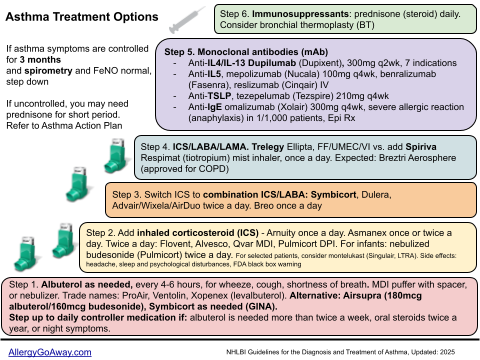This is a Twitter summary from the 2018 WSAAI meeting. This summary was compiled from the tweets posted by @MatthewBowdish, an allergist/immunologist, who attended the 2018 Western Society of Allergy, Asthma and Immunology (WSAAI) meeting. The tweets were labeled #WSAAI. The text was edited and modified by me.
Mario Castro on Asthma Heterogeneity, Phenotypes & Endotypes - Choosing the Right Biologic for your Patient.
Potential Biomarkers for Asthma Assessment & Management:
- sputum eosinophils
- blood eosinophils
- IgE
- FeNO
Potential phenotype-targeted therapies in severe asthma: https://twitter.com/MatthewBowdish/status/955543915645386752
Site of action of targeted therapies for severe asthma: https://twitter.com/MatthewBowdish/status/955550700020236288
Targeted therapies based on severe asthma phenotypes with associated biomarkers: https://twitter.com/MatthewBowdish/status/955551030934056960

Asthma Treatment Options in 7 Steps (click to enlarge the image).
Three anti-IL5 mAb:
Issues affecting the choice between one anti-IL5 vs. another:
- blood eosinophil level
- exposure to drug
- disease severity
- level of baseline control
- other patient factors (polyps/sinus dz)
Mepolizumab significantly reduces number of exacerbations in pts with severe asthma, lowers blood & sputum eos counts with IV dose (SC dose w/variable effects), has small effects on FEV1, AQLQ and ACQ scores but not significantly different from placebo, safety similar to placebo.
Reslizumab (3 mg/kg IV q 4wks) showed reductions in sputum esos, exacerbations, improvements in airway fxn and greater asthma control than placebo & was well tolerated. Also can use criteria using blood eos, asthma control, lung fxn and disease severity.
Benralizumab has effect on exacerbations, lung function and asthma control with a positive correlation between degree of benefit and baseline blood eosinophil counts. Acceptable safety profile.
Now on to another biologic class - Dupilumab, an anti-IL4 receptor alpha that affects IL4 and IL13 that is approved for atopic dermatitis but is being evaluated for asthma.
Is chronic airflow obstruction and airway modeling a phenotype, or an end-result from many different pathways? Further studies using targeted thermoplasty (ie on ventilation) may help answer this question.
Mario Castro on Asthma Heterogeneity, Phenotypes & Endotypes - Choosing the Right Biologic for your Patient.
Potential Biomarkers for Asthma Assessment & Management:
- sputum eosinophils
- blood eosinophils
- IgE
- FeNO
Potential phenotype-targeted therapies in severe asthma: https://twitter.com/MatthewBowdish/status/955543915645386752
Site of action of targeted therapies for severe asthma: https://twitter.com/MatthewBowdish/status/955550700020236288
Targeted therapies based on severe asthma phenotypes with associated biomarkers: https://twitter.com/MatthewBowdish/status/955551030934056960
Asthma Treatment Options in 7 Steps (click to enlarge the image).
Three anti-IL5 mAb:
Issues affecting the choice between one anti-IL5 vs. another:
- blood eosinophil level
- exposure to drug
- disease severity
- level of baseline control
- other patient factors (polyps/sinus dz)
Mepolizumab significantly reduces number of exacerbations in pts with severe asthma, lowers blood & sputum eos counts with IV dose (SC dose w/variable effects), has small effects on FEV1, AQLQ and ACQ scores but not significantly different from placebo, safety similar to placebo.
Reslizumab (3 mg/kg IV q 4wks) showed reductions in sputum esos, exacerbations, improvements in airway fxn and greater asthma control than placebo & was well tolerated. Also can use criteria using blood eos, asthma control, lung fxn and disease severity.
Benralizumab has effect on exacerbations, lung function and asthma control with a positive correlation between degree of benefit and baseline blood eosinophil counts. Acceptable safety profile.
Now on to another biologic class - Dupilumab, an anti-IL4 receptor alpha that affects IL4 and IL13 that is approved for atopic dermatitis but is being evaluated for asthma.
Is chronic airflow obstruction and airway modeling a phenotype, or an end-result from many different pathways? Further studies using targeted thermoplasty (ie on ventilation) may help answer this question.